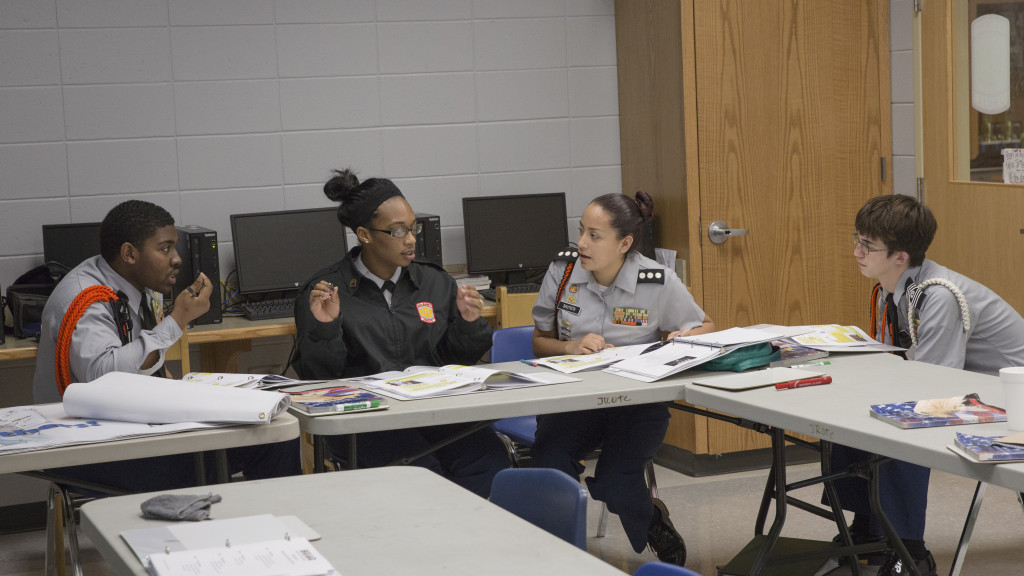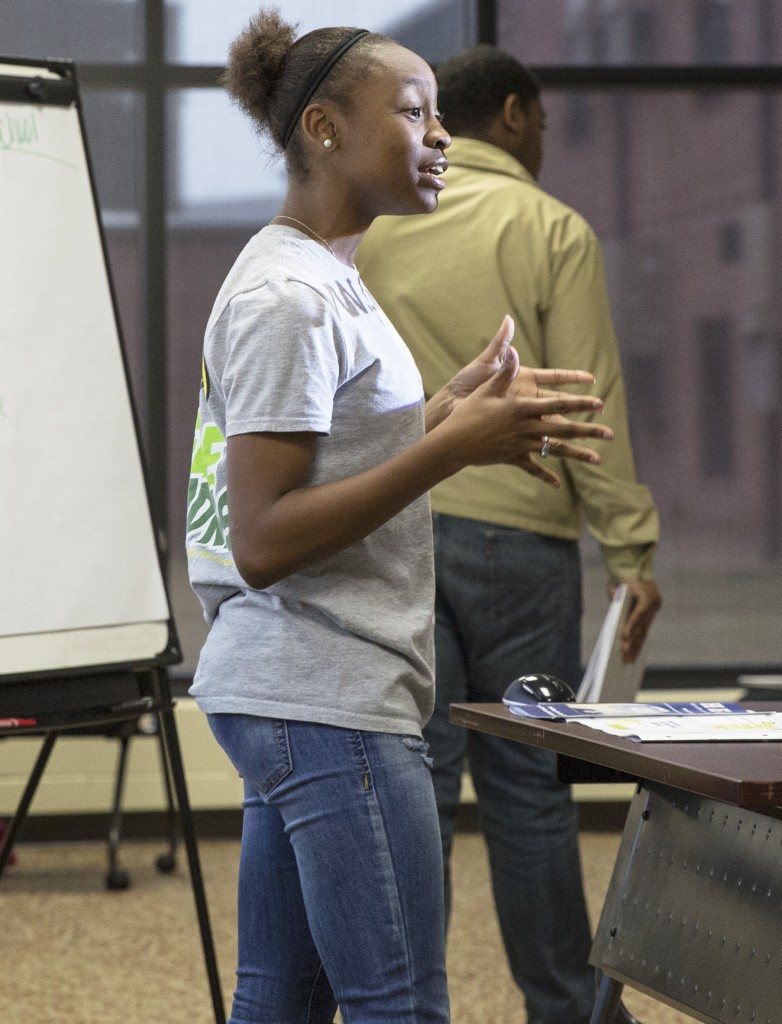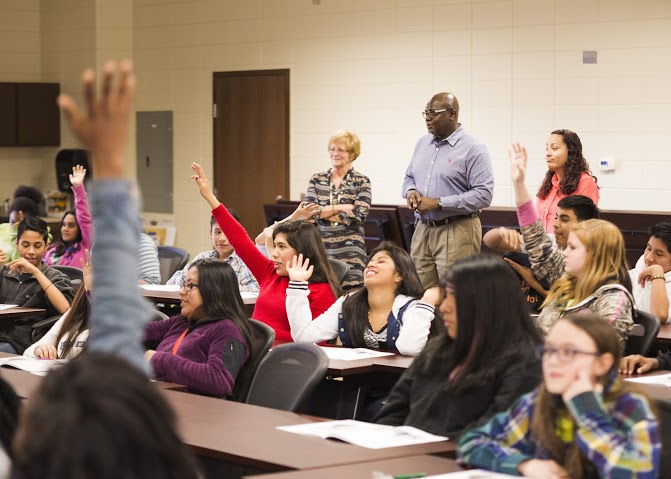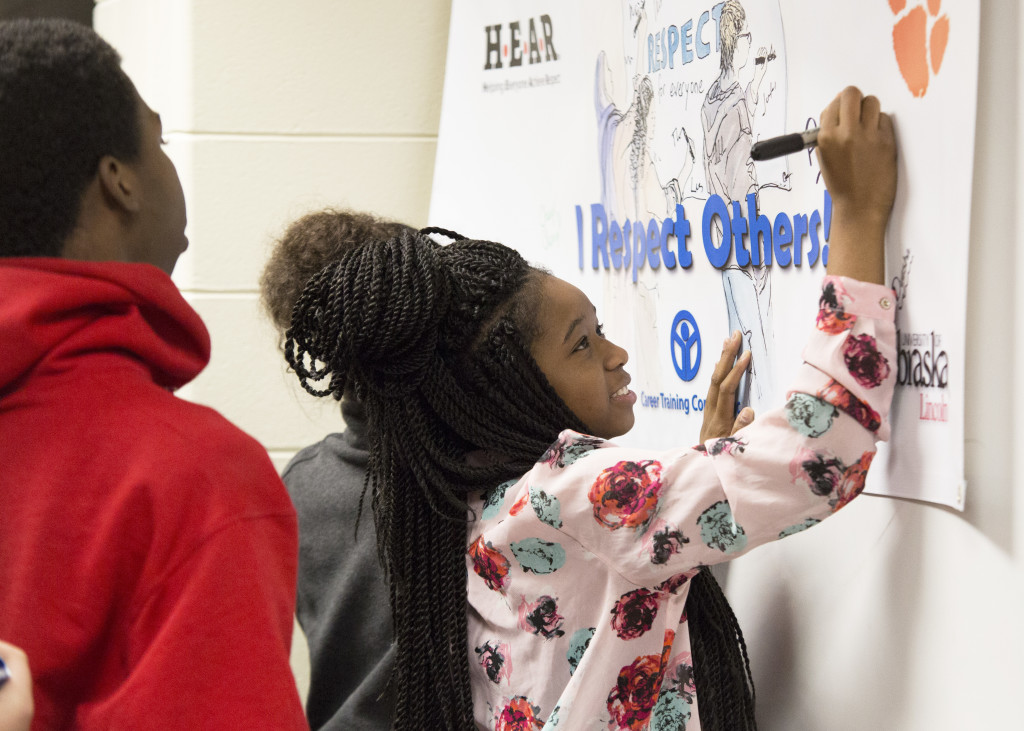
Metter High school students prepare to present HEAR at the local middle school.
Upbeat music plays as eighth graders in Candler County, Georgia are welcomed into a classroom by nine excited and friendly students from the local high school. The older students recognize their unique position to influence young lives. They were selected, trained, studied, practiced, coordinated roles, and prepared the classroom with instructional material and technology. The HEAR – Helping Everyone Achieve Respect workshop begins as two seniors take the lead. They immediately capture their 8th grade audience’s attention with a strong introduction and palpable sense of comradery. The objective is two-fold: 1. Facilitate HEAR to help middle schoolers better understand the many forms of bullying, its harmful effects, and strategies to stop it, and 2. Inspire each one to take action to create and uphold an expectation that only respectful words and actions will be used in their school. Anything less is unacceptable and uncool.

With an energetic introduction, Imani,a high school senior, kicks off the HEAR workshop to a classroom of 8th graders.
Let’s step back from this classroom observation to look at the bigger picture. The instructional model – high school students teaching HEAR to younger students – was recently pioneered in the Candler County School District in Georgia. HEAR – Helping Everyone Achieve Respect was developed by experts from University of Nebraska-Lincoln and Harvard Graduate School of Education in collaboration with Career Training Concepts. The interactive workshop was designed for high school and middle school students to actively engage young minds in developing ideas to combat bullying. HEAR for High Schools is presented by trained members of the National Guard and is offered at no cost to schools. HEAR for Middle Schools is available at a minimal cost, and after training, may be presented by educators, community volunteers and now, as we found in Candler County, outstanding high school students.
Anecdotal and survey data suggest that HEAR resonated with learners using this model. This may be the case for several reasons. First, high school students can be influential agents of change. On this occasion, eighth graders listened, looked, and responded to their HEAR instructors, who were close enough in age to be relatable and elevated enough in grade level status to be respectable. High school and middle school students have a mutual understanding of school culture and real life knowledge of what it’s like to be a young person with a common need to belong in a world of challenges, like cyberbullying.
For example, as students discussed a cyberbullying scenario in HEAR, one high school student explained, “Just like you can type ‘I love you,’ you can type something hateful that can ruin someone’s life. Does everyone see why bullying is not cool?” Another instructor said, “Most of us have phones, let’s use them wisely so no one gets hurt!” The conversation continued as younger students agreed and offered their own thoughts about consequences of misused technology and possible solutions to stop it. The high school and middle school students just seemed to “get each other.”
Another possible reason HEAR resonated with the audience is because the high school instructors showed interest, empathy and concern for those following in their footsteps and asked them to do the same for others. One instructor insisted, “If you see someone bully and you do nothing…well, please don’t let that happen. School should be where we come to learn and never a place to feel beat up.” Other words of wisdom spoken from the hearts and minds of teens: “Think about how others feel, always take the high road, and don’t judge others over anything.”
Finally, high school students encouraged active learning with other teaching strategies that work, such as relating learning to real life, making connections to common experiences, modeling (e.g., how to tell a bully that her behavior is not okay), thoughtful questioning, respectful listening and probing for deeper responses, praising, and integrating reading and writing. Of course, they also made learning fun and interesting with humor and novelty.
Local education experts who observed the HEAR workshop took notice of student engagement. “I was extremely pleased with the HEAR program,” noted Dr. Bubba Longgrear, Superintendent, Candler County Schools. “This interactive and scenario-based program enables students to talk and identify anti-bullying solutions themselves. Our students and ultimately our school environment will benefit.”

Principal Ralph Carlyle and community member and Chair of the Candler County Foundation for Public Education, Dr. Nancy Norton, observe students’ engagement in the HEAR workshop.
“Using high school students as instructors is a unique and effective strategy – they can ‘speak the language’ of middle school students,” noted Dr. Nancy B. Norton, Chair of the Candler County Foundation for Public Education. “I believe that if this program is implemented and becomes a part of the culture of the school, it can go a long way toward alleviating the serious problem of bullying.” The school district is planning to invite the high school instructors to return to teach HEAR to all 6th and 7th graders in the near future.
The story of this unique HEAR experience would not be complete without describing its conclusion. After discussing strategies and solutions to combat bullying, leaders of the presentation spoke to their audience about ways that they, too, can rise up as leaders who don’t just sit back and watch bad things happen, but instead DO something. One boy raised his hand and expressed his fear that high school might be an unwelcoming and intimidating place for new kids. The 11th grade instructor smiled and said, “And YOU have the power to change things when you get there next year!”

Wishing to make a difference, students sign the “I RESPECT OTHERS” banner after the presentation.
After providing several concrete ways students can lead positive change, the instructors passed out surveys and explained that teachers, the school counselor and the principal can use the information to make school an even better place. She indicated where to neatly place the completed surveys and then turned to her final request. With explicit instructions given, she encouraged students to sign a commitment banner on their way out of the classroom if they plan to do their best to show respect to everyone. Each student, row by row, signed the “I Respect Others” banner.
HEAR’s message was presented in a common language and with a level of energy that added a personal and uniquely effective touch to the interactive student experience. After a job well done, one high school student expressed how much she appreciated taking responsibility for helping fellow students combat bullying. “I liked teaching the middle school students HEAR because this program is needed in our schools. People need to know that bullying is not ok and that it needs to be stopped.” It is quite probable that other high school students in other districts share this attitude, capability and eagerness to make a difference. Giving them the opportunity will have a profound effect on schools.
